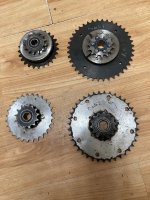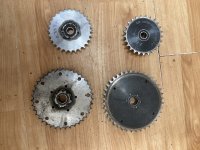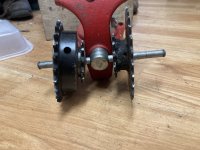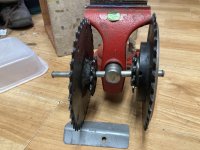DingusMcGee
100 kW
For starters an ebike motor essentially already has a flywheel. It is the heavy rotor of the BLDC motor. The simplest way to add more flywheel effect is to get more rotating mass on any part of the motor drive train that turn any time the motor rotor turns instead of making a bigger flywheel/rotor to fit(?) inside the motor case. The part of that drive train easiest to add flywheel effect with the tools I have is to add weight/mass to the rotating DSBBH (double sprocket bottom bracket hub.
Sprockets come in type A sprocket and type B sprocket . A type A sprocket is thin sheet of metal with teeth. A type B sprocket is a type A sprocket with a hub fastened to it. In a fashion the DSBBH hub is the combination of a type A sprocket fastened to a type B sprocket. When the DSBBH is fabricated with the larger sprocket type B, a larger rotating mass is achieved — more flywheel effect than making the DSBBH with the smaller sprocket type B.
See pics of the DSBBHs fabrications used in some of the tests:




These sprockets were made so as to be able to switch bearings for either a square tape BB spindle or an Isis BB spindle.
The physical quantity for the measurement of flywheel effect is the second moment of inertia (I). The measurement accounts for the observation that more rotational inertia is achieved as a given rotating mass gets further from the rotation center and this effect is non linear.
I am running out of time but will post the conclusion next post.
Sprockets come in type A sprocket and type B sprocket . A type A sprocket is thin sheet of metal with teeth. A type B sprocket is a type A sprocket with a hub fastened to it. In a fashion the DSBBH hub is the combination of a type A sprocket fastened to a type B sprocket. When the DSBBH is fabricated with the larger sprocket type B, a larger rotating mass is achieved — more flywheel effect than making the DSBBH with the smaller sprocket type B.
See pics of the DSBBHs fabrications used in some of the tests:




These sprockets were made so as to be able to switch bearings for either a square tape BB spindle or an Isis BB spindle.
The physical quantity for the measurement of flywheel effect is the second moment of inertia (I). The measurement accounts for the observation that more rotational inertia is achieved as a given rotating mass gets further from the rotation center and this effect is non linear.
I am running out of time but will post the conclusion next post.
Last edited:

